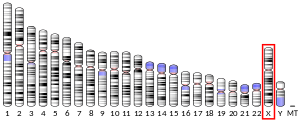TMLHE
Trimethyllysine dioxygenase, mitochondrial is an enzyme that in humans is encoded by the TMLHE gene in chromosome X.[4][5][6] Mutations in the TMLHE gene resulting in carnitine biosynthesis disruption have been associated with autism symptoms.[7]
| TMLHE | |||||||||||||||||||||||||
|---|---|---|---|---|---|---|---|---|---|---|---|---|---|---|---|---|---|---|---|---|---|---|---|---|---|
| Identifiers | |||||||||||||||||||||||||
| Aliases | TMLHE, AUTSX6, BBOX2, TMLD, TMLH, TMLHED, XAP130, D430017M14Rik, trimethyllysine hydroxylase, epsilon | ||||||||||||||||||||||||
| External IDs | OMIM: 300777 MGI: 2180203 HomoloGene: 21853 GeneCards: TMLHE | ||||||||||||||||||||||||
| |||||||||||||||||||||||||
| Orthologs | |||||||||||||||||||||||||
| Species | Human | Mouse | |||||||||||||||||||||||
| Entrez | |||||||||||||||||||||||||
| Ensembl | |||||||||||||||||||||||||
| UniProt | |||||||||||||||||||||||||
| RefSeq (mRNA) | |||||||||||||||||||||||||
| RefSeq (protein) | |||||||||||||||||||||||||
| Location (UCSC) | Chr X: 155.49 – 155.67 Mb | n/a | |||||||||||||||||||||||
| PubMed search | [2] | [3] | |||||||||||||||||||||||
| Wikidata | |||||||||||||||||||||||||
| |||||||||||||||||||||||||
Structure
The TMHLE gene is located at the extreme end of the Xq28 region with high genomic instability,[8] and encodes a protein trimethyllysine dioxygenase, a, Fe2+ and 2-oxoglytarate dependent non-heme-ferrous iron hydrolase localized to the mitochondrial matrix.[9]
Function
The trimethyllysine dioxygenase enzyme catalyzes the first step in the carnitine biosynthesis pathway,[9] which is part of amine biosynthesis. Carnitine is a molecule that play an essential role in the transport of activated fatty acids across the inner mitochondrial membrane where they are metabolized. The encoded protein converts trimethyllysine into hydroxytrimethyllysine with the reaction (EC 1.14.11.8):
N6,N6,N(6)-trimethyl-L-lysine + 2-oxoglutarate + O2 = 3-hydroxy-N6,N6,N(6)-trimethyl-L-lysine + succinate + CO2.
and requires iron and L-ascorbate as co-factors.
Clinical significance
Mutations in the THLHE gene causes Epsilon-trimethyllysine hydroxylase deficiency (TMLHED),[10][11] an inborn error of metabolism in carnitine biosynthesis, which may increase the risks of developing neurodevelopmental disorders, autism-related behaviors, and Autism spectrum disorders.[12][7]
Interactions
THLHE has been shown to have 14 binary protein-protein interactions including 12 co-complex interactions. THLHE appears to interact with SUGCT.[13]
References
- GRCh38: Ensembl release 89: ENSG00000185973 - Ensembl, May 2017
- "Human PubMed Reference:". National Center for Biotechnology Information, U.S. National Library of Medicine.
- "Mouse PubMed Reference:". National Center for Biotechnology Information, U.S. National Library of Medicine.
- Rogner UC, Heiss NS, Kioschis P, Wiemann S, Korn B, Poustka A (October 1996). "Transcriptional analysis of the candidate region for incontinentia pigmenti (IP2) in Xq28". Genome Research. 6 (10): 922–34. doi:10.1101/gr.6.10.922. PMID 8908511.
- Vaz FM, Ofman R, Westinga K, Back JW, Wanders RJ (September 2001). "Molecular and Biochemical Characterization of Rat epsilon -N-Trimethyllysine Hydroxylase, the First Enzyme of Carnitine Biosynthesis". The Journal of Biological Chemistry. 276 (36): 33512–7. doi:10.1074/jbc.M105929200. PMID 11431483.
- "Entrez Gene: TMLHE trimethyllysine hydroxylase, epsilon".
- Ziats MN, Comeaux MS, Yang Y, Scaglia F, Elsea SH, Sun Q, Beaudet AL, Schaaf CP (September 2015). "Improvement of regressive autism symptoms in a child with TMLHE deficiency following carnitine supplementation". American Journal of Medical Genetics. Part A. 167A (9): 2162–7. doi:10.1002/ajmg.a.37144. PMID 25943046.
- Monfregola J, Napolitano G, Conte I, Cevenini A, Migliaccio C, D'Urso M, Ursini MV (2007). "Functional characterization of the TMLH gene: promoter analysis, in situ hybridization, identification and mapping of alternative splicing variants". Gene. 395 (1–2): 86–97. doi:10.1016/j.gene.2007.02.012. PMID 17408883.
- Monfregola J, Cevenini A, Terracciano A, van Vlies N, Arbucci S, Wanders RJ, D'Urso M, Vaz FM, Ursini MV (2005). "Functional analysis of TMLH variants and definition of domains required for catalytic activity and mitochondrial targeting". J. Cell. Physiol. 204 (3): 839–47. doi:10.1002/jcp.20332. PMID 15754339.
- Celestino-Soper PB, Shaw CA, Sanders SJ, Li J, Murtha MT, Ercan-Sencicek AG, Davis L, Thomson S, Gambin T, Chinault AC, Ou Z, German JR, Milosavljevic A, Sutcliffe JS, Cook EH, Stankiewicz P, State MW, Beaudet AL (2011). "Use of array CGH to detect exonic copy number variants throughout the genome in autism families detects a novel deletion in TMLHE". Hum. Mol. Genet. 20 (22): 4360–70. doi:10.1093/hmg/ddr363. PMC 3196886. PMID 21865298.
- Nava C, Lamari F, Héron D, Mignot C, Rastetter A, Keren B, Cohen D, Faudet A, Bouteiller D, Gilleron M, Jacquette A, Whalen S, Afenjar A, Périsse D, Laurent C, Dupuits C, Gautier C, Gérard M, Huguet G, Caillet S, Leheup B, Leboyer M, Gillberg C, Delorme R, Bourgeron T, Brice A, Depienne C (2012). "Analysis of the chromosome X exome in patients with autism spectrum disorders identified novel candidate genes, including TMLHE". Transl Psychiatry. 2: e179. doi:10.1038/tp.2012.102. PMC 3565810. PMID 23092983.
- http://www.omim.org/entry/300872
- "14 binary interactions found for search term TMLHE". IntAct Molecular Interaction Database. EMBL-EBI. Retrieved 2018-08-25.
Further reading
- Hartley JL, Temple GF, Brasch MA (November 2000). "DNA cloning using in vitro site-specific recombination". Genome Research. 10 (11): 1788–95. doi:10.1101/gr.143000. PMC 310948. PMID 11076863.
- Simpson JC, Wellenreuther R, Poustka A, Pepperkok R, Wiemann S (September 2000). "Systematic subcellular localization of novel proteins identified by large-scale cDNA sequencing". EMBO Reports. 1 (3): 287–92. doi:10.1093/embo-reports/kvd058. PMC 1083732. PMID 11256614.
- Wiemann S, Arlt D, Huber W, Wellenreuther R, Schleeger S, Mehrle A, Bechtel S, Sauermann M, Korf U, Pepperkok R, Sültmann H, Poustka A (October 2004). "From ORFeome to biology: a functional genomics pipeline". Genome Research. 14 (10B): 2136–44. doi:10.1101/gr.2576704. PMC 528930. PMID 15489336.
- Monfregola J, Cevenini A, Terracciano A, van Vlies N, Arbucci S, Wanders RJ, D'Urso M, Vaz FM, Ursini MV (September 2005). "Functional analysis of TMLH variants and definition of domains required for catalytic activity and mitochondrial targeting". Journal of Cellular Physiology. 204 (3): 839–47. doi:10.1002/jcp.20332. PMID 15754339.
- Mehrle A, Rosenfelder H, Schupp I, del Val C, Arlt D, Hahne F, Bechtel S, Simpson J, Hofmann O, Hide W, Glatting KH, Huber W, Pepperkok R, Poustka A, Wiemann S (January 2006). "The LIFEdb database in 2006". Nucleic Acids Research. 34 (Database issue): D415-8. doi:10.1093/nar/gkj139. PMC 1347501. PMID 16381901.
- Monfregola J, Napolitano G, Conte I, Cevenini A, Migliaccio C, D'Urso M, Ursini MV (June 2007). "Functional characterization of the TMLH gene: promoter analysis, in situ hybridization, identification and mapping of alternative splicing variants". Gene. 395 (1–2): 86–97. doi:10.1016/j.gene.2007.02.012. PMID 17408883.

